Relevance: Sociology: Social Movements in Modern India: G.S paper III: Internal Security: Linkages between development and spread of extremism. Role of external state and non-state actors in creating challenges to internal security.
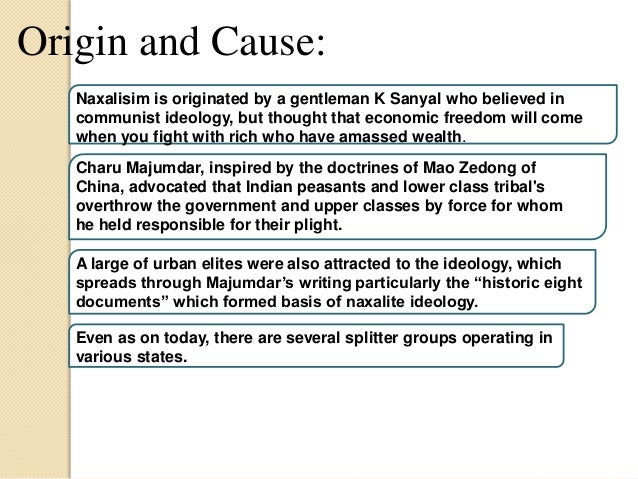
Introduction
The term ‘Naxal’ derives from the name of the village Naxalbari in West Bengal, where the movement had its origin. The Naxals are considered far-left radical communists, supportive of Maoist political sentiment and ideology. Their origin can be traced to the split in 1967 of the Communist Party of India (Marxist), leading to the formation of the Communist Party of India (Marxist–Leninist).
Initially the movement had its centre in West Bengal. In later years, it spread into less developed areas of rural southern and eastern India, such as Chhattisgarh, Odisha and Andhra Pradesh through the activities of underground groups like the Communist Party of India (Maoist).
For the past 10 years, it has grown mostly from displaced tribal‟s and natives who are fighting against exploitation from major Indian corporations and local officials whom they believe to be corrupt.

- Naxal, Naxalite and Naksalvadi are generic terms used to refer to various militant Communist groups operating in different parts of India under different organizational envelopes. In the eastern states of the mainland India (Chhattisgarh, Jharkhand, West Bengal and Odisha), they are usually known as, or refer to themselves as Maoists while in southern states like Andhra Pradesh they are known under other titles. They have been declared as a terrorist organization under the Unlawful Activities (Prevention) Act of India (1967). Leaders of the movement have been found to have hideouts located in China.
- The Government of India had made certain provisions were made to stop the influx and to rehabilitate the affected population. And the problem lies on the grass root level of its implementations. Now the problem lies how these laws and provisions can be communicated to the isolated mass in an substantiated way. In Short, in this study we attempt to find out the Causes and Solutions for Naxalite Movement In India.
Real Position of Naxalite Movement Many civil society activists working in Maoist-affected areas are similarly finding themselves under assault from both sides. The Maoists claim to be fighting for the poor and the marginalized, demanding loyalty and shelter from villagers, while government forces seek public support in protecting those same villagers from the Maoists. But the activities of civil society activists on behalf of the impoverished and vulnerable local population put them at risk from the Maoists and government security forces alike.
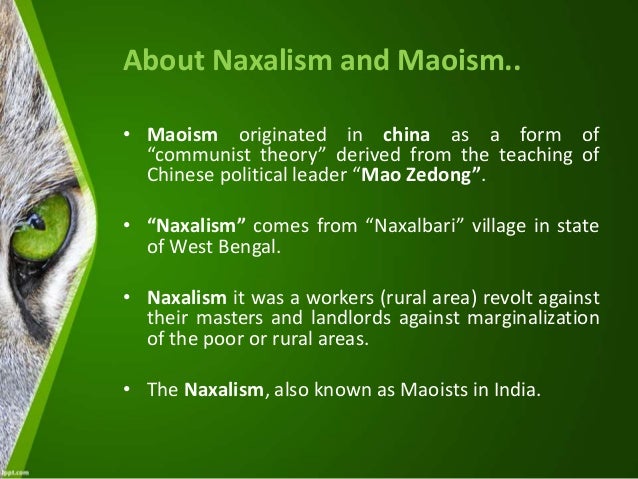
The Maoists have a significant presence in the states of Chhattisgarh, Orissa, Andhra Pradesh, Maharashtra, Jharkhand, Bihar, and West Bengal, and a marginal presence in Assam, Madhya Pradesh and Uttar Pradesh.
The Maoists assert that they are defending the rights of the marginalized: the poor, the landless, Dalits, and tribal indigenous communities. They call for a revolution, demanding a radical restructuring of the social, political, and economic order.
- The Maoists believe the only way marginalized communities can win respect for their rights is to overthrow the existing structure by violent attacks on the state. Various state governments have responded to this challenge by carrying out security operations to defeat the Maoist movement, provide protection for local residents, and restore law and order. The police in these states receive support from central government paramilitary forces. Various state and national forces often conduct joint operations, in part to deny the Maoists sanctuary in other states.
- Because of the ineffective response by states, in 2009 the central government started to coordinate security operations. The situation in Chhattisgarh is undoubtedly deeply distressing to any reasonable person. What was doubly dismaying to us was the repeated insistence that the only option for the State was to rule with an iron fist, establish a social order in which anyone speaking for human rights of Citizens are to be deemed as suspect, and a Maoist .
- Causes of Naxalite Movement The lack of human development causes anger and resentments amongst the people. They feel alienated and excluded. In addition often local elites are engaged in exploiting, harassing and even torturing the tribal population
- The Naxalites receive most support from Dalits and Adivasis. Together they amount for one fourth of India‟s population; most of them live in rural India. Their causes for supporting the violent movement are manifold. Among these groups persists low degree of employment and qualification, new forest policies with restriction for their livelihoods, cultural humiliation, weak access to health care, education and power, restricted and limited access to natural resources, multifaceted forms of exploitation, social atrocities, displacement and deficient rehabilitation programs, political marginalization and suppression of protests.
Mehra has underlined that the most affected states have a huge number of people facing huge deprivation, especially among Dalits and Adivasis. Moreover these respective states show a high record on crimes that are committed against the neglected groups as well as displacement due to economic and development projects
- In fact 80% of the total displaced persons within the period of 1947 – 2000 were tribal‟s. A large number of tribal‟s were not regarded by state services as well as governmental development projects. Attempts by the states to increase its influence in the most backward areas resulted in repression of the inhabitants by state authorities such as by the forest departments and subsequently resulted in the destruction of their traditional social bond. The most Naxal affected areas Jharkhand, Bihar, Chhattisgarh, Madhya Pradesh, and Andhra Pradesh are rich in natural resources. In this area, natural resources are not only reason of promoting Naxalite movement. It could be one of the reasons, but not the only reason. It is doubtful whether it could be considered even as the primary reason.
-
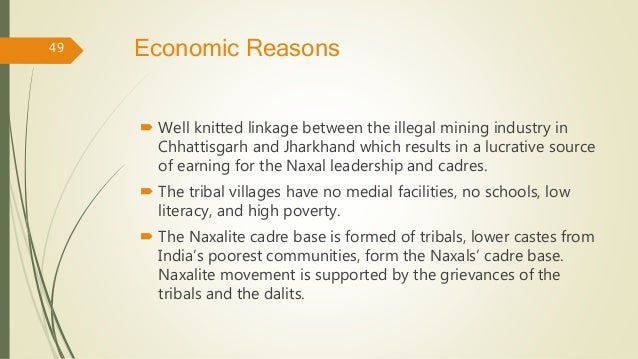
If natural resources or lack of it is a major reason for the Naxalite conflict, then why is there is a Naxalite problem in Jharkhand, but not in Himachal Pradesh? Why in Bihar, and not in eastern Uttar Pradesh? Are natural resources an accurate parameter to measure growth of the Naxal problems in these regions?
Either the state or Union government controls natural resources like mountains, forests, reservoirs, rivers and mineral resources like coal, mica, bauxite, and cooper.
The state remains the arbiter and distributor while the individuals or groups of individuals have little say in this matter. Individuals have exploited the state for their own benefits, but the problem lies with the failure of governance by the state, but not with individuals. The reason for the growth of Naxalite problem could be enumerated. The slow implementation of land reforms is the main reason for the growth of Naxalism.
Landlords frequently moved the court to delay implementation of these reforms. They also connived with local politicians and bureaucrats, making the land reform process slow and cumbersome. Land reforms failed in the end.
The social structure of society in these areas could be cited as a second reason for emergence of the Naxalite problem. Invariably, wherever the Naxalite problem exists, there is a poor section of society, with no resources to meet their quality requirements. It is correct in not attributing the caste or tribal structure as a reason for the problem. The poor include various castes and not any particular caste or group of castes. However, their poverty and lack of ability to improve their lot due to financial constraints by accessing education, the government machinery or even legal remedies remains an important factor for their supporting the Naxalites.
Though poverty limits their reach, there has been a limited exposure to these ideas of the younger generation, making the situation dangerous. The local adage is that little knowledge is more dangerous embodies the problem in rural areas.
The younger generation wants to have the facilities that are available in urban areas, which remains a distant dream given the infrastructural problems and the failure of governments to perform. Schooling is poor it not non-existent, hence the rural youth fight a losing battle against their urban youth counterparts.
This forces them to return to rural areas, still aspiring for urban facilities. The failure of the government to reach out to these areas is another major factor that aids the growth of Naxalism in these areas. The governance is poor or worse, in certain places it is non-existent.
Popular schemes take long to devise but longer to implement. Even while implementing, the benefit always reach those who are the „naves‟ and not those who are in need. The failure in formulation and implementation of the right schemes at the right time, and targeting the right people is the major problem.
Despite the rise of the Naxalite problem the state failed to tackle it effectively by providing the needed economic and political measures. The state failed to perform its duties; in short, governance, or the lack of it, in these areas is a primary reason for the growth of the Naxalite problem. Furthermore, political interference has also played a significant role in the implementation of governmental schemes. Leaders have always tried to delay the projects promote by opponent parties.
On the contrary, the Naxalite groups have been collecting levies from the local population. They collect funds from individuals, groups, and even government officials as commissions for letting them function in areas that are under their control.
This money is used by the Naxalite groups to buy arms and recruit new members, especially from the unemployed youths in rural areas. Since the Naxalites provide a monthly salary and uniform, they have become popular amongst the unemployed youths.
Thus the growth of Naxalite movement is due to various factors, it is not merely a question of sharing natural resources. The causes of the Maoist movement in India are structural. Economic, political and cultural dimensions are closely linked.
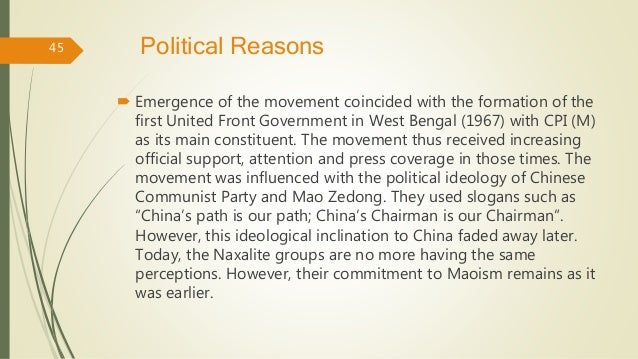
The first is the economic situation which is exploited by Naxalites and their extreme left ideology. It seems much like a catch-22 situation. On the one hand, India has experienced relatively fast economic growth, which has led to increased levels of national wealth. To facilitate and continue this development, businesses need more land and natural resources such as minerals.
On the other hand, this economic growth has been uneven among regions, and has widened the disparity between the rich and the poor. Proponents of these businesses argue that these regions need economic development, if they are to catch up with their richer counterparts.
The Indian aboriginals, known as adivasis, live these richly forested lands, which are wanted for development by businesses.
The conflict between economic progress and aboriginal land rights continues to fuel the Naxalite‟s activities. Their strongest bases are in the poorest areas of India. They are concentrated on the tribal belt such as West Bengal, Orissa, and Andhra Pradesh where locals experience forced acquisition of their land for developmental projects.
The spread of Naxalism reflects the widespread alienation and discontentment felt by large parts of the country that are systematically marginalized.
Dr. Subramanian, a former Director-General of the National Security Guard and Central Reserve Police Force notes that Naxalism exists in these tribal areas because of the dissatisfaction of the people against the government and big businesses, the terrain is suitable for guerrilla tactics, and there is no existence of a proper and effective local administration mechanism. In these areas, the conditions are conducive to warfare and extremist ideologies. Even if Naxalites are simply exploiting the adivasis‟ situation for their own ends, their popularity indicates the power of the root causes to create such an environment for insecurity and violence.

Naxalite movement as the biggest threat
The Naxalite threat is the biggest security problem for India’s future as its effects are multi-layered. The Maoist movement highlights India’s interior weaknesses, which makes India also vulnerable to external threats. As part of globalization, threats such as the Naxalite movement can no longer be viewed as simply internal as it also affects external security.
The security dangers are aptly described by a former Pakistani Director-General of the Inter-Services Intelligence and his description of India’s foreign affairs. The Director-General equated India being busy with internal security problems to having two extra Divisions in the Pakistan Army for free.
A nation cannot effectively withstand threats coming from outside its country if there is instability inside it. Furthermore, globalization has encouraged the emergence of non-state terrorist actors as well as international interference in each other’s affairs.
India has been one of the victims of international and state sponsored terrorism fuelled by fundamentalist ideologies. India’s regional neighbors are also external threats.
For example, in 2004, the MHA was wary of the “symbiotic relationship” between the Communist Party of Nepal and Naxal groups in India. This means having military deployed along the border. In the past, India has also been involved in territorial disputes with China such as over Aksai Chin. Another reason why the Naxalites are the biggest threat to security is because of the way the issue affects India‟s economic development. This is apparent in several ways.
For example, the more the Maoists concentrate on the poor and marginalized regions of India, the more economic development (which is imperative to improving those regions‟ conditions) will be hampered.
Furthermore, the Naxalite rebels are no longer just focusing on remote jungles but on urban centers. Maoist leader Kishenji even declared that the group aims to establish an armed movement in Calcutta by 2011.
The Laws Made by the Government
Rehabilitation and Resettlement Policy, 2007 : The main aim of this act is to minimize the displacement of people and to promote non-displacing or least displacing alternatives. The Government issued a rehabilitation policy on 11 October 2007 for the easy displacement of people who lose their land for industrial growth. Under this policy land in change for land will be given, job prospective to at least one member of the family, vocational training and housing benefits including houses to people in rural areas and urban areas will be some of the benefits.
Forest Rights Act, 2006 : The Scheduled Tribe and Other Traditional Forest dwellers (Recognition of forest Rights) Act 2006 or the Forest Rights Act recognizes the rights of the scheduled tribes and forest dwellers who have been living in the forests for years but their rights have still not been recognized. The Ministry of Environment and Forests has also allowed use of 1 hectare of land for non-forest purposes and conversion of kattcha roads into pakka roads.
Chhattisgarh Special Public Securities Act, 2006 : This bill provides definition of unlawful activities, declaring an organization unlawful, formation of an advisory board wherever the state government feels the need for its establishment, procedure of the formation of the advisory board, action of the advisory board, penalties viz punishments even for not committing a crime, the power to notify a place being used for unlawful activities and taking occupation of such place thereof and revision/bar against intervention by the courts.
Are these laws effective? : These laws have in many ways caused a lot of problems to the tribal’s and the scheduled castes by negating the spirit of the various safeguards available to the scheduled tribes under the constitution and other laws in the country. The act providing ‘land for land’ has become a nightmare for the government and has become a stumbling block for ensuring industrialisation.
As per the Unlawful activities prevention act (UAPA) the government has banned all organisations that have any connections with any Naxal movements like the MCC or the CPI-M (Marxist-Leninist).
CSPS Bill, 2005: It provides the District Magistrate unconditional powers to notify places which he thinks are being used for unlawful activities without any prior notification.
This bill also provides that any revision application has to be filed with the High court only, challenging the validity of the order of the government. This petition has to be filed within 30 days and that no court has the jurisdiction against any decision of the court. Any kind of application or form of revision or injunction by a court or officer except for the High court and the Supreme Court regarding any action to be taken as a follow up to the order of the government has been barred in this Bill. So it can be said that this bill was totally uncalled for and has only be brought to act as a blandishment to the people.
Way Forward
The complexity of the causes of the Naxalite problem as well as its implications both for internal and external security reflect a solution that is multi-dimensional and calls for a synergy between the central governments and the states. In order to comprehensively dissolve the Naxalite threat, the government has to address its root causes.
Socio-economic alienation and the dissatisfaction with the widening economic and political inequality will not be solved by military force alone, which seems to be the main instrument employed by the government. The problem calls for a three-pronged solution: social and economic development, multi-lateral dialogue and military force.
Socio-economic development: As the Naxalites are fuelled by discontent from the marginalized and the poor, a larger percentage of the national budget must be allocated to addressing the needs of these regions. More of the national expenditure needs to be focused on developing these poorer regions through initiatives regarding health, education, social welfare and rural and urban development.
Government service delivery should be improved in these tribal areas. Both state and government must ensure that things such as statutory minimum wages, access to land and water sources initiatives are implemented. In coming up with strategies for national economic growth, the government must always bear in mind the possible effects of fast growth for all socio-economic groups in a country as large and diverse as India. If the social needs of these marginalized people are addressed, there will be no discontent to fuel the Naxalite’s movements.
Dialogue : Second, the government should initiate sincere dialogue with these marginalised groups, the Naxalites and state leaders. The popularity of Naxalites with the adivasis is a reflection of the fact that the government has been unaware or “unapologetically indifferent to their plight”. By communicating and starting a dialogue between these stakeholders, these groups will feel that they being listened to. By opening dialogue, the government can give opportunity for the rebels to join the mainstream by showing them that solutions can be created together with the government, by being part of the political system in a legitimate way. They no longer need to resort to violence to get the state‟s attention.
For example, the former director-general of AP concluded that as a result of the ceasefire and dialogue with Maoists in 2004, the violence in the state decreased by 80-90 percent in the region. As David Pilling noted, the challenge for India‟s leaders will be to allow the necessary development in these poverty-stricken areas while acknowledging the rights of a neglected indigenous group.
Military: Currently, the main instrument employed by the government to address the Naxalite threat is the increasing use of the military. While some military force is still needed to combat against the Maoist guerrillas, it should not be the only solution. By only addressing the issue by brute force, government risks alienating civilians who are caught in the middle. Coercion of the state will only encourage people to rally against it.
Governance: The growing Naxalite insurgency also reflects a flaw in the federal structure. Because law and order is seen as a state responsibility, the central government is unable to be implementing a coherent national strategy to address the threat. The government has the overall responsibility of mobilizing development, but it cannot do so without the support of the states. The central government and the states need to cooperate together to solve the internal security threats and co-ordinate the implementation of this multi-dimensional approach. Both organizations must complement and support each other’s initiatives and strategies.
Conclusion
Therefore the state must start to fight the conflict legally, minimize collateral damage, strengthen the leadership of the security forces and abstain from any human rights violation.
The security forces should better start protecting the population living within the area of conflict instead of merely confronting the Maoists on large scale. The Naxalite movement must be challenged politically by presenting better alternatives to the Maoist approach and offer new perspectives.
In this regard the state should start addressing the basic needs of the poor and fulfilling its main responsibilities to deliver human development to these disadvantaged areas.
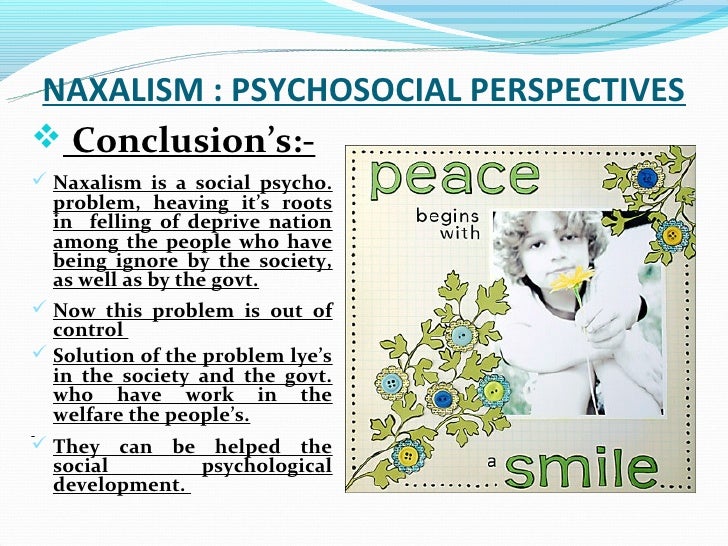
For more such notes, Articles, News & Views Join our Telegram Channel.
Click the link below to see the details about the UPSC –Civils courses offered by Triumph IAS. https://triumphias.com/pages-all-courses.php

